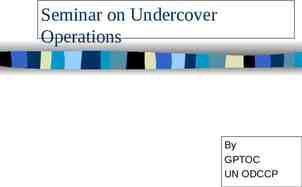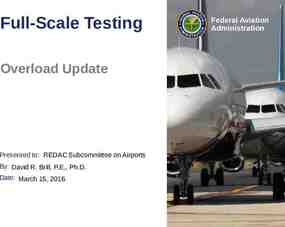STRATEGIES for URBAN RENEWAL in CITY CENTRES Introduction to
22 Slides298.93 KB

STRATEGIES for URBAN RENEWAL in CITY CENTRES Introduction to City Improvement Districts CIGFARO - October 2017 Area Based Service Delivery Eddie Scott

Constitution - Section 152 – Objects of local government (1) The objects of local government are – (a) To provide democratic and accountable government for local communities; (b) To ensure the provision of services to communities in a sustainable manner; (c) To promote social and economic development; (d) To promote a safe and healthy environment; and (e) To encourage the involvement of communities and community organisations in the matters of local government. (2) A municipality must strive, within its financial and administrative capacity, to achieve the objects set out in subsection (1).

CID vs SRA Council determines a Special Rating Area ito legislation SRA functions as a CID (City Improvement District) Also called SRAs, BIDs, Community Improvement Districts, etc. CIDs are an organ of state and external service provider

What is a CID? Geographically bound area determined by the Steering Committee, and The Business Plan is supported by majority of property owners within the area Who are willing to pay additional rates on their property To fund additional municipal services to improve/upgrade the area

CID Model Purpose Enhance and supplement municipal services Facilitate investment Facilitate a co-operative approach between the City and private sector Halt degeneration and facilitate upliftment of distressed business and mixed use areas Promote economic growth and sustainable development Promote urban regeneration through sustainable urban management Upgrades and improves areas

CIDs improve and upgrade area By: Improving SAFETY - making the public area SAFE for its community and visitors Combatting GRIME – making the area CLEAN Initiating ENVIRONMENTAL improvements – making the area greener in all aspects Accepting SOCIAL RESPONSIBILITY – dealing with the homeless, HIV/AIDs, vagrants prostitution, adopt a charity as a project etc. Regenerating the environment through urban management

Legal framework SRA By-Law - MPRA (Section 22 – guides establishment) MFMA (Fiscal governance) MSA (Ability to determine cent-in-the-rand and collect) Constitution (Schedules 4 & 5 – municipal functions) Comp Act (Governance and accountability) MOI (meeting protocols, operational structure)

Legal framework / continued SRA Policy Establishment criteria Institutional arrangements Establishment principles Business Plan content Dissolution Financial control (fiscal governance) Rates Policy (Relief) Credit Control and Debt Collection Policy (Billing, arrears) Finance Agreement (Financial reporting and responsibilities) MATR (Municipal Asset Transfer regulations) Any other Act, By-law, Policy and Regulation applicable to CCT SARS, tax relief ito section 18(A) for donors/sponsors

Typical CID Services - Provide additional municipal services to: - Enhance public safety and security - Supplement cleansing services - Create environmental awareness - Expand social/community involvement Provide urban management by: - Combatting urban decay/degeneration - Upgrading/improving the environment Create joint ventures with Council / NGOs / PBOs / SAPS etc.

Typical Benefits Focussed management of area Pride in communal achievements Create social responsibility Environmental awareness (recycling, greening, energy efficiency, conservation) Low vacancy rates Attract new capital investments Marketing / promoting of area Increase in property values All contribute to Budget Brings confidence in property prices Decreases the need for private security thus lowers insurance premiums

Advantages for the communities Control over own money To be spent in own CID only as per approved BP Appoint own service providers Everybody contributes (extensive financial modelling to ensure affordability) Contributions are capped Weighted votes and capping Set own standards / service levels Pool resources (COCT / NGOs / CIDs etc.) CoCT support (Political representation as observers and officials) Sub Council ward allocations No debt management No administrative fee payable to City Public money – monitored by COCT CoCT collect additional rates and payover on budget to ensure sustainability

Benefits for the Municipality Enhanced service delivery Better relations with the communities Protection of the rates base Shifting the rates burden Combats degeneration of CBD and other areas Upgrades and improves the area at the cost of the property owners Attracts investments Improves cash flows Creates job opportunities Improved and sustainable urban management Stimulates local economy Can have management contracts with CIDs

Challenges Financial impact on individual property owners - model affordability and sustainability Possible political interference If approved by Council then mandatory for all (Democratic process) Gentrification Explore models for poorer areas including alternate funding Guard that Departments do not abdicate services/responsibilities thus CIDs become primary rather than top-up service providers Gain co-operation from Service Departments to include CID related interventions in their SDBIPs iro extended service delivery Develop suitable SLAs indicating benchmarks for primary service delivery including turn around times for repairs and maintenance Educating CID directors on their roles and responsibilities as prescribed in legislation to ensure compliance and to allow them to focus on service delivery Ensuring that CIDs operate ito their mandates and within the law

Establishment principles Arrears Profile after boundary confirmation (at risk) Services are specific to the needs of the area (urban management survey) Majority support (Area classified as Commercial 50% and classified as Residential 60%) so mandatory participation One property one vote for establishment NPC will be the management structure (also register as PBO) Municipal valuation determines members’ portion (CID additional rates) of CID budget CID additional rates collected by the City Additional rates to be spent in CID only as per approved Business Plan Dissolution mechanism (50% plus 1 vote per property)

Establishment Process 2 years to establish Has 5 year term (apply to renew) Stringent application of “rules” to protect Council, Community and Steering Committee against potential litigation Ensure credibility of model as applied Each area unique Driven by property owners Facilitated by CCT: who guides / advises process Ensures legal compliance

Statistics 39 existing CIDs, 4 new established 1 July 2017 CIDs cumulative spend since inception: R1,5Bn CIDs cumulative arrears since inception: 30 days R15,9m; 60 days R13,1m CIDs cumulative retention balance (VAT incl) since inception: R40m CIDs budgets 2017/18 : R199m 12 months moving average payment ratio: 100,3% as at 30 June2017 Communities pursuing establishment: 16

Establishment of CIDs per year

Questions

Thank you

MPRA: Section 22 Local Authority can determine Special Rating Areas in consultation with local community Additional rates for additional services (top up) within that area The SRA can be administered by Council or community

Section 22- SRA Part 4: Additional rates Special rating areas 22. (1) A municipality may by resolution of its council— (a) determine an area within that municipality as a special rating area; b) levy an additional rate on property in that area for the purpose of raising funds for improving or upgrading that area; and (c) differentiate between categories of properties when levying an additional rate referred to in paragraph (b). (2) Before determining a special rating area, a municipality must— (a) consult the local community, including on the following matters: (i) the proposed boundaries of the area; and (ii) the proposed improvement or upgrading of the area; and (b) obtain the consent of the majority of the members of the local community in the proposed special rating area who will be liable for paying the additional rate. (3) When a municipality determines a special rating area, the municipality— (a) must determine the boundaries of the area; b) must indicate how the area is to be improved or upgraded by funds derived from the additional rate;

Section 22- SRA continued (c) must establish separate accounting and other record-keeping systems regarding— (i) the revenue generated by the additional rate; and (ii) the improvement and upgrading of the area; and (d) may establish a committee composed of persons representing the community in the area to act as a consultative and advisory forum for the municipality on the improvement and upgrading of the area, provided representivity, including gender representivity, is taken into account when such a committee is established. Such a committee must be a subcommittee of the ward committee or committees in the area, if the municipality has a ward committee or committees in the area. (4) This section may not be used to reinforce existing inequities in the development of the municipality, and any determination of a special rating area must be consistent with the objectives of the municipality’s integrated development plan. (5) This section must be read with section 85 of the Municipal Systems Act if this section is applied to provide funding for an internal municipal service district established in terms of that section of the Municipal Systems Act.






